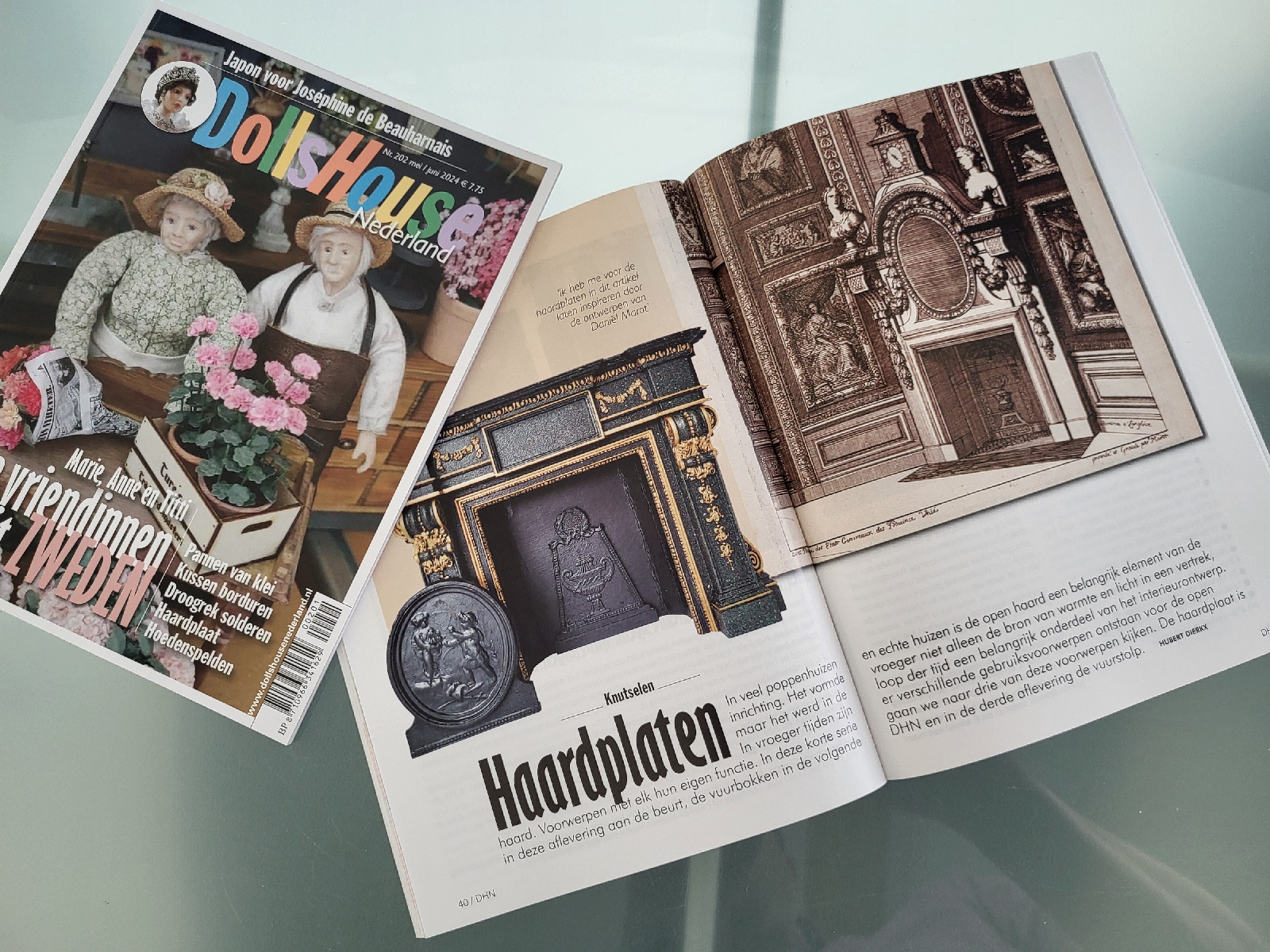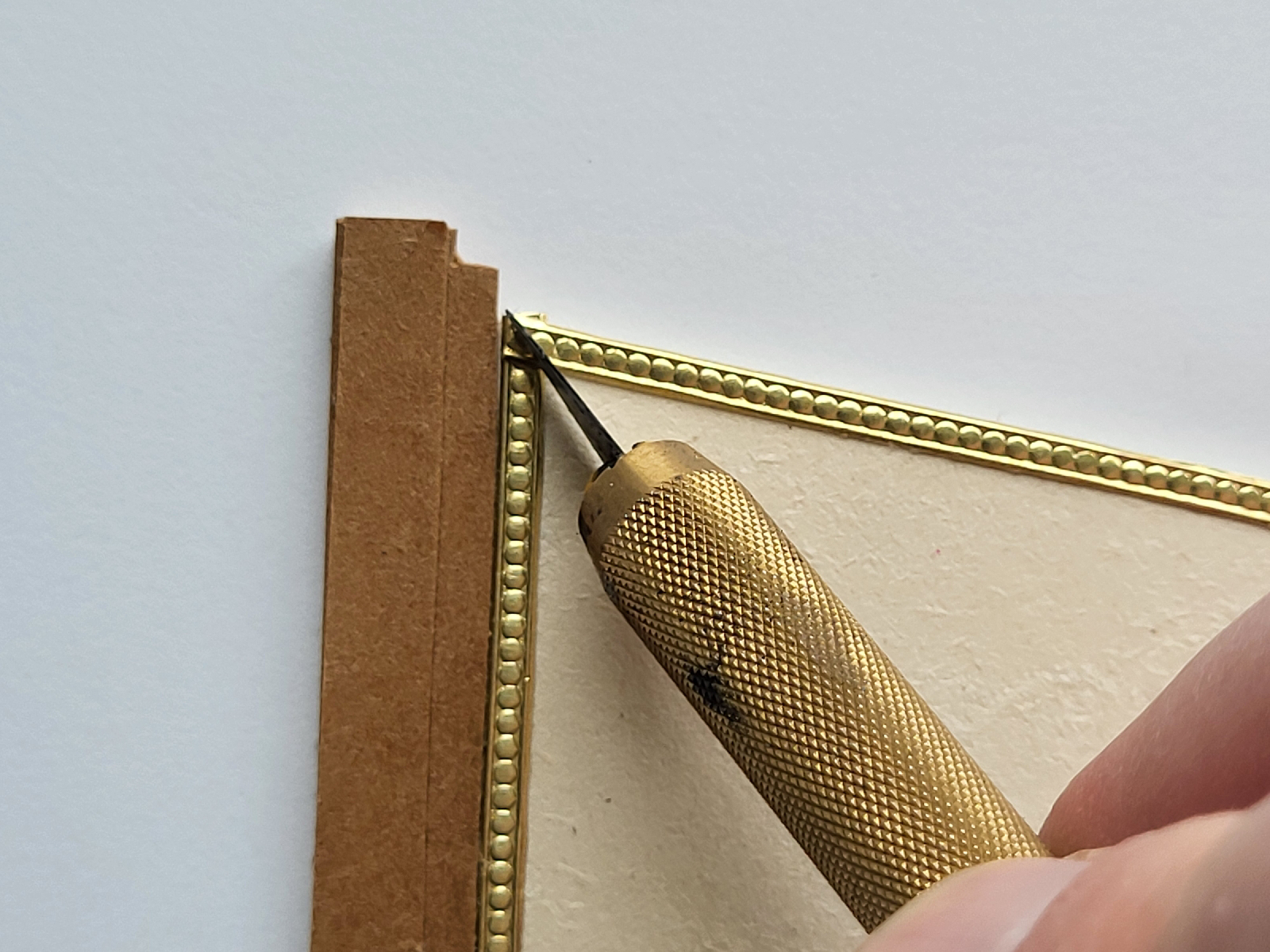Just a quick post with some more firebacks. In THIS POST, a few years back, I showed you 4 firebacks made out of brass and copper stampings, cardstock and black enamel paint. I also explained in that post how I made them.
Since then I have found some more stampings that I would like to turn into fire backs for Huis ter Swinnendael. Following my article about Lady Zonneschut's dressing room I was asked by DHN magazine if I wanted to write a few articles for them about the several miniatures I had made for the fireplace. And show how easy it can be to make them oneself.
We decided to make it a series of three articles. The first would be on fire backs, also sometimes called back plates, the second on andirons, and the third and last one on curfews. We started of with the fire backs that grace the back wall of a fireplace. These can be simple without any decoration or with a date, or a star/ sun/ moon in relief on them.
They can also be highly decoratated. In the article I first explained that in the course of the 17th century became a real part of the decorating scheme for grand fireplaces in the houses/castles of the well to do. Architect Daniël Marot for example, designed them together with the fireplace they would be the part of. And sometimes they were designed together with the rest of the room to form a complete design.
Because I did wan to make this an easy project any miniaturist can do (I'm no pro either), I showed two ways to make them. One with a ready made metal stamping, and one with the use of Dresden paper.
The stampings I use cán be quite costly. But why not use a decorative coin or an old medal found in a car boot sale? And it need not be metal either. (although those are often highly detailed) Why not use a cameo made of plastic, plaster or resin? Amy ornament in low relief will do. The description of the fire back with an ornament is the same as my previous post. Read all about it here!
With those stampings or cameo's the limitation is that the shape of the ornament you use, dictates the shape of the fireback. When it is oval the fire back is best left with an oval top half too.
When you use Dresden paper, or other such ornaments, you can decide on the shape and use the paper ornaments to fill that shape in and enhance it.
All that is needed here is a template. I used the Daniël Marot engraving for inspiration. I had drawn the template on paper. Glued that to 2 mm thick cardstock and cut it out. For the base I cut out two pieces of thin cardboard. For decoration I used a baroque vase, a laurel wreath and three pieces of a border with a pearl motive.
Because the corners are not on 90 degrees I glued the borderpieces on the card board without gluing the ends. Cut right through both pieces in the middle got the right angle. All I had to do then was to glue the ends on the cardboard. And then you get something like in the picture below.
All we needed to do then was to paint it all black with satin finish enamel paint to mimic cast iron.
And there we have two more firebacks. At the same time my collection of fireplaces have grown as well. In the second article I make three sets of andirons in different styles. In my post on that article I'll show you some of my self made and self decorated fireplaces.
Until next post!
Huibrecht
















Realmente bonitas!!!
ReplyDeleteBesos.
Dear Huibrecht, Congratulations on your published articles! It is always great to be reminded that the simplest materials (cardboard and paper and glue!) can produce such outstanding results! Your fireplace backs are outstanding! I look forward to see the next articles! :):):)
ReplyDeleteHoi Huibrecht! Gefeliciteerd met de plaatsing van jouw artikelen in de DHN, gaaf!
ReplyDeleteJouw uitleg voor het maken van deze realistisch lijkende haardplaten is duidelijk, de effecten zijn geweldig mooi geworden, dankjewel voor het delen. Ik ben benieuwd naar het vervolg.
Fijne avond.
Groet, Ilona
This is impressive - a series of three articles for this well known magazine. Congratulations - to you as being published is something very special but even more to DHN for being smart enough to ask the right man for this special topic. As you already do on this blog you've also supplied the readers of the DHN magazine with great ideas and inspirations. And what I like the best is whenever simple materials are used while thinking a bit out of the box to achieve the most unbelievable results.
ReplyDeleteHugs
Birgit
Muy ingenioso. Quedan espectaculares!!!
ReplyDelete